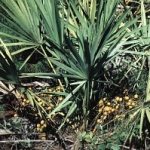| Common Name: |
Saw Palmetto |
| Botanical Name: |
Serenoa repens syn. S. serrulata |
| Genus: |
Serenoa |
| Family: |
Arecaceae |
| Native Location: |
SE USA (South Carolina to Florida Keys, and west to Alabama and Missouri |
| Cultivation: |
Moist to wet soil in sun or dappled shade. Plants grown under glass may be attacked by spider mites and scale insects. |
| Propagation: |
By seed sown in spring; by separation of suckers in spring. Divided clumps are difficult to re-establish. |
| Harvest: |
Fruits are collected when ripe, partly dried for elixirs, infusions, liquid extracts, and tinctures, or dried and powdered for use in tablets. |
| Height: |
2-4m (6-12ft) |
| Width: |
Indefinite |
| Hardiness: |
Min. 7°C (45°F) |
| Parts Used: |
Fruits |
| Properties: |
A sedative, warming, tonic herb with a soapy taste and pungent, vanilla-like aroma. It affects the endocrine system, is a urinary antiseptic, diuretic, and expectorant, and is reputedly aphrodisiac. |
| Medicinal Uses: |
Internally for impotence, low sex drive, debility in elderly men, prostate conditions, cystitis, bronchial complaints associated with coldness, and wasting diseases; also to encourage breast enlargement in women. May be combined with Equisetum arvense (See, Field Horsetail) and Hydrangea arborescens (See, Wild Hydrangea) for enlarged prostate. |
| Culinary Uses: |
Fruits and seeds are edible. |
| Bibliography: |
Encyclopedia of Herbs by Deni Brown Copyright © 1995, 2001 Dorling Kindersley Limited Pg 367 |

